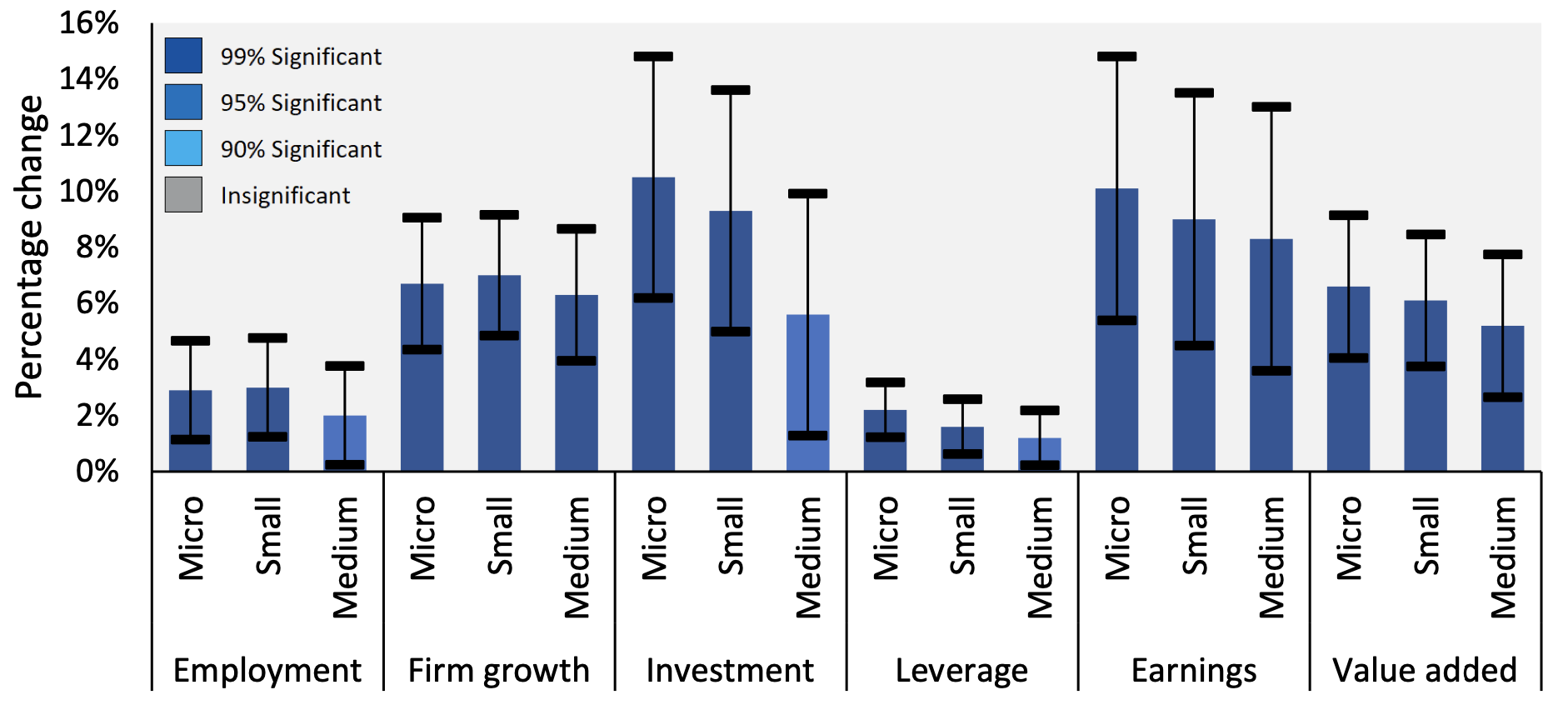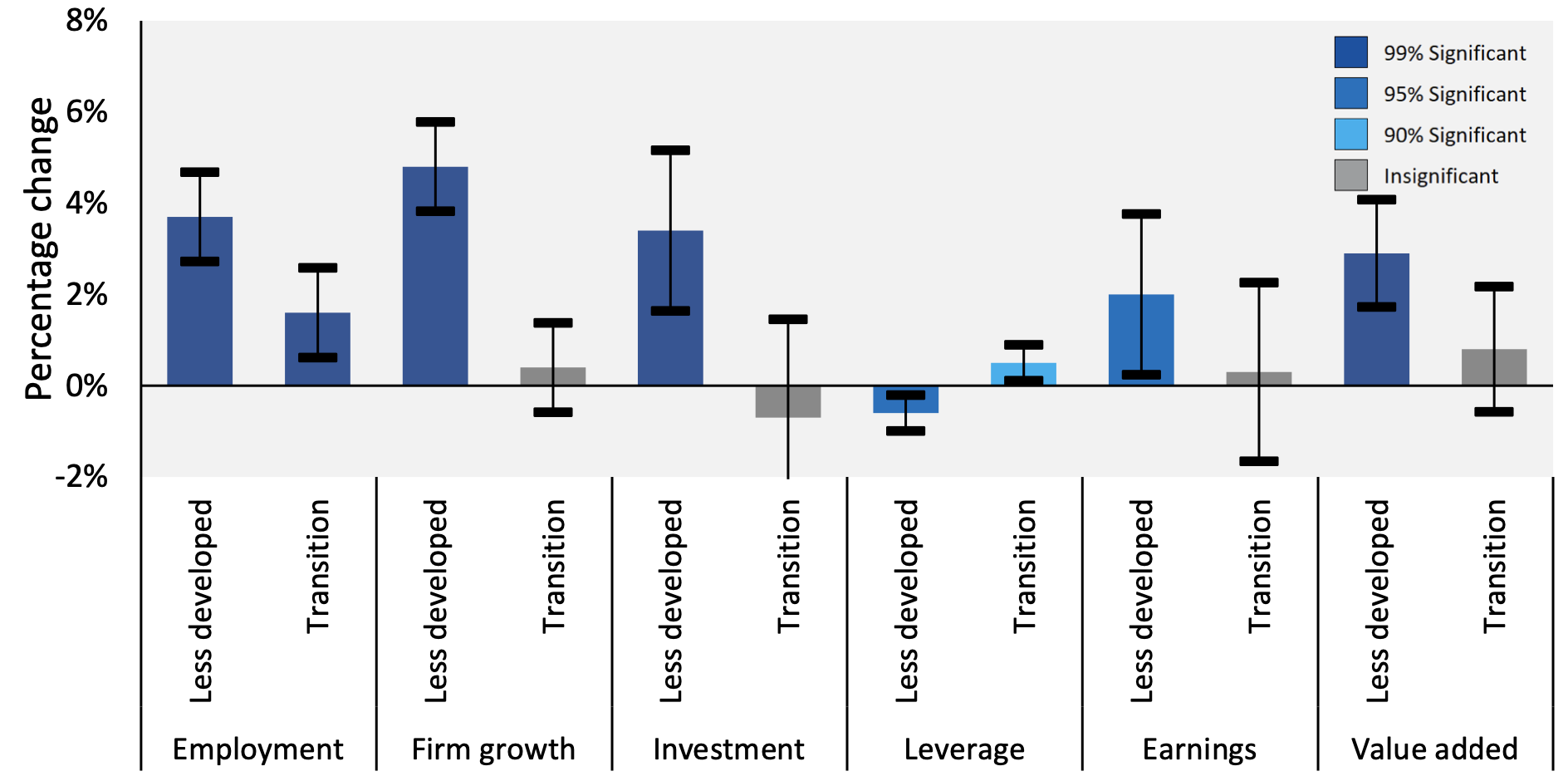Small and medium enterprises (SMEs) constitute the backbone of the EU economy.
Despite their importance, however, SMEs have long been affected by credit constraints that pose a significant barrier to their investments, limiting their growth (Kaplan and Zingales 1997, Beck and Demirguc-Kunt 2006, Ferrando and Mulier 2015, Ayyagari et al. 2021). As limited access to finance for SMEs is primarily due to greater asymmetric information costs and lack of sufficient collateral, national and international public financial institutions have been supporting SMEs’ access to finance in various forms, including direct lending, loan guarantees, micro-credit and intermediated loans. Moreover, national governments implemented a broad set of measures to support the resilience of firms in response to the COVID-19 shock (van der Wielen et al. 2021), including public loans and state-backed loan guarantees.
Assessing the impact of public support programmes, however, is key to fine-tuning their design and assessing their performance. Following the example by Brown and Earle (2017) for the US Small Business Administration’s loan guarantee programme, European evidence attributes positive employment, firm growth and investment impacts to support schemes in the form of direct lending (e.g. Erhardt 2017), loan guarantees (e.g. Bertoni et al. 2019), venture capital (e.g. Pavlova and Signore 2019) and venture debt (Gatti et al. 2022).
The impact of the European Investment Bank’s intermediated lending
The European Investment Bank (EIB) supports access to finance and SME sector development through intermediated lending, in particular Multiple Beneficiary Intermediated Loans (MBILs). Under this scheme, the EIB provides loans to financial intermediaries – banks, leasing companies or other financial institutions – under more favourable conditions than the market, either directly or indirectly (through public promotional institutions). The financial intermediaries are then mandated to use the funds to extend loans to SMEs and mid-caps and to partially transfer them the financial advantage they benefit from in the form of an interest rate reduction and/or provision of longer tenors.
There is limited empirical evidence, however, on the impact of intermediated lending activities and their heterogeneous effect across SMEs. Earlier analyses of the EIB’s SME financing focused on MBILs between 2008 and 2014 to recipient firms in Central and Eastern Europe (Gereben et al. 2019), showing a positive impact on employment. Extensions to the EU confirm this positive impact (Wolski and Gereben 2020; Amamou et al. 2023) and find evidence that the longer maturities and more advantageous loan pricing of EIB-supported loans are associated with larger employment and investment effects (Barbera et al. 2021).
Our recent analysis (Sinnott et al. 2023) complements this existing work by providing new additional results. Relative to their peers, EIB loan beneficiaries experience significantly higher employment growth (see Figure 1). EIB intermediated lending beneficiaries report employment numbers that are 5.4% higher on average in the three years after the loan. EIB beneficiaries’ growth, as measured by total assets, also increases by 6.0% relative to that of the control group in the three years after the loan. On average, beneficiary firms report 15.3% higher investment, as measured by the increase in their tangible fixed assets in the three-year period after the loan. The substantial investment push is associated with a limited but significant increase in firms´ leverage, around two percentage points.
Despite the absence of a direct, significant impact on recipients’ profitability, MBIL beneficiaries report significant increases in both their earnings and productivity, as measured by value added. Beneficiaries are more likely to submit patents, resulting in a small yet statistically significant impact (of 1.1%) in patent filings in the three years after the loan is received. Nevertheless, EIB beneficiaries report considerably higher (13.3%) intangible fixed assets than their peers in the three years after the loan.
Figure 1 Average impact of EIB loan in the three years after the loan
Source: Sinnott et al. (2023)
Differences in impact across firms
Smaller firms benefit significantly more from EIB-supported loans. Relative to mid-cap beneficiaries, micro, small and medium-sized EIB loan recipients show significantly higher growth in employment, firm size, investment, leverage, earnings and productivity in the three years after the loan (see Figure 2).
Relative to mid-cap beneficiaries, micro, small and medium-sized EIB loan recipients invest 11%, 9% and 6% more, respectively. Given the close link between firms’ size and their access to finance, separate results also show that beneficiaries that are classified as financially constrained grow faster upon receiving an EIB intermediated loan. These results are relevant in light of EIB’s support to firms’ access to finance, as large firms are generally less financially constrained than smaller ones.
Figure 2 Impact by firm size (estimates relative to mid-caps)
Source: Sinnott et al. (2023)
Differences in impact across regions
On top of supporting SME’s access to finance and development, the EIB aims to foster regional development and cohesion. Firm-level studies have shown that cohesion policy support promotes the growth, employment and productivity of firms (Benkovskis et al. 2019, Bachtrogler et al. 2020). In this respect, our evidence from the EIB-backed intermediated lending to SMEs and mid-caps confirms the stronger additionality of the loans for beneficiary firms in less developed regions.
Practically, we classify the firms in our sample based on their NUTS2 region codes. Following the 2014-2020 Cohesion Region classification, regions are classified as less developed regions where GDP per inhabitant was less than 75% of the EU average, as transition regions where GDP per inhabitant was between 75% and 90% of the EU average, and as more developed regions where GDP per inhabitant was more than 90% of the EU average.
Firms in less developed regions benefit substantially more from EIB intermediated lending. Estimation results show that relative to beneficiaries located in more developed regions, beneficiaries in less developed regions experience a higher impact on employment, firm growth, investment, earnings and productivity by 2 to 5% (see Figure 3). Recipients in transition regions report increases in employment that are about 2% higher than those in more developed regions.
Figure 3 Impact by cohesion-type region (estimates relative to firms in more developed regions)
Source: Sinnott et al. (2023)
It is important to emphasise that an insignificant impact (as indicated by a grey bar) does not mean there is no overall positive impact of EIB lending. It solely indicates that the impact for that subgroup is not statistically different from the comparative group, firms in more developed regions in this case.
Conclusion
Smaller firms began to experience deteriorating financing conditions in 2022 due to monetary tightening and a rise in the risk aversion of investors (Revoltella et al. 2023). Consequently, demand for publicly funded loans is likely to increase given that some businesses may find it more difficult to access credit and that the interest rate conditions are more favourable than those provided by the market. In light of this, it is reassuring to know that such schemes are not just filling a market gap but, in fact, helping beneficiaries grow and invest, providing an instrument to protect business investment in a period of tightening credit and heightened uncertainty.
Authors’ note: The views expressed are those of the authors and do not necessarily reflect the position of the European Investment Bank.
References
Amamou, R, A Gereben and M Wolski (2023), “Assessing the impact of the EIB’s intermediated lending to SMEs during funding shocks”, Small Business Economics 60: 975–1007.
Ayyagari, M, P Juarros, M S Martinez Peria and S Singh (2021), “Access to Finance and Job Growth: Firm-Level Evidence across Developing Countries”, Review of Finance 25(5): 1473-1496.
Bachtrogler, J, U Fratesi and G Perucca (2020), “The influence of the local context on the implementation and impact of EU Cohesion Policy”, Regional Studies 54: 21–34.
Barbera, A, A Gereben and M Wolski (2022), “Estimating conditional treatment effects of EIB lending to SMEs in Europe”, EIB Working Papers 2022/03.
Beck, T and A Demirguc-Kunt (2006), "Small and medium-size enterprises: Access to finance as a growth constraint", Journal of Banking & Finance 30(11): 2931-2943.
Benkovskis, K, O Tkacevs, N Yashiro and B Javorcik (2019), “Importance of EU regional support programmes for firm performance”, Economic Policy 34: 267–313.
Bertoni, F, J Brault, M G Colombo, A Quas and S Signore (2019), "Econometric study on the impact of EU loan guarantee financial instruments on growth and jobs of SMEs", EIF Working Paper Series 2019/54.
Brown, J D and J S Earle (2017), "Finance and Growth at the Firm Level: Evidence from SBA Loans", Journal of Finance 72(3): 1039-1080.
Erhardt, E C (2017), "Microfinance beyond self-employment: Evidence for firms in Bulgaria," Labour Economics 47(C): 75-95.
Ferrando, A and K Mulier (2015), "Firms’ Financing Constraints: Do Perceptions Match the Actual Situation?", The Economic and Social Review 46(1): 87-117.
Gatti, M, S Schich, W van der Wielen and E Sinnott (2022), “Impact assessment of EIB venture debt”, European Investment Bank.
Gereben, A, A Rop, M Petriček and A Winkler (2019), “The impact of international financial institutions on small and medium enterprises: The case of EIB lending in Central and Eastern Europe”, EIB Working Papers 2019/09.
Kaplan, S N and L Zingales (1997), “Do investment-cash flow sensitivities provide useful measures of financial constraints?”, Quarterly Journal of Economics 112(1): 169-215.
Pavlova, E and S Signore (2019), "The European venture capital landscape: an EIF perspective. Volume V: The economic impact of VC investments supported by the EIF", EIF Working Paper Series 2019/55.
Revoltella, D, T Bending, L Maurin and S Kolev (2023), “Sustaining resilience and renewal in Europe: The facts shaping the way forward”, VoxEU.org, 1 March.
Sinnott, E, M Gatti and W van der Wielen (2023), “Impact assessment of the EIB’s intermediated lending to businesses”, European Investment Bank.
van der Wielen, W, D Revoltella, L Maurin, R Pál and P Harasztosi (2021), “Firm-level policy support during the Covid-19 crisis: So far so good”, VoxEU.org, 18 November.
Wolski, M and A Gereben (2020), “The impact of public sector lending to SMEs on employment and investment”, VoxEU.org, 29 April.









